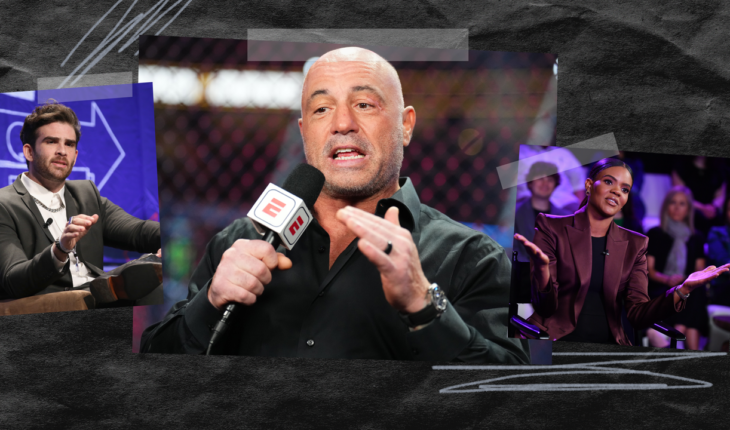
“I want to thank the Nelk Boys, Adin Ross, Theo Von, Bussin’ With the Boys, and last but not least, the mighty and powerful Joe Rogan,” said UFC CEO Dana White when handed the microphone during Donald Trump’s victory speech on election night. Rather than shout out a slew of Republican senators, White singled out a handful of popular podcasters and influencers who arguably had more to do with Trump taking the stage at about 2:30 a.m. that night than your run-of-the-mill politician in Washington.
White’s remarks spoke to the Trump campaign’s savvy media strategy of courting large male audiences—and was a harbinger of the “Democrats need a Joe Rogan” discourse that has followed the party’s resounding defeat. In conversations I’ve had since with prominent voices on the right and the left, as well as with journalists steeped in internet culture, it’s clear the Democrats need to engage more effectively through nontraditional media. And while there are opportunities for the party to connect, there’s also no quick fix to match a right-leaning, male-centric media ecosystem, or manosphere, that’s growing into a MAGA megaphone.
“This shift has been happening for literal years,” says Taylor Lorenz, a tech journalist and author of the book Extremely Online. “You can look at the evolution of something like Barstool Sports, which is part of this as well. The right has always succeeded in personality-driven environments. They recognized back in the ’90s, in the days of talk radio, that personality-driven media is just far more effective at reaching people and promoting their messaging.” She also points to the sports, gaming, and YouTube prank culture as subtle ways that young people were gradually exposed to increasingly conservative ideology.
Lorenz, who produces an online culture publication on Substack, User Mag, says that the content space leans right because the people who created the environment have always felt “shut out” from traditional media channels, Hollywood, and mainstream pop culture, which they feel is “controlled by liberals.”
In the final stretch of the 2024 election, Trump appeared on numerous podcasts and livestreams, including The Joe Rogan Experience, This Past Weekend With Theo Von, Full Send, and more, while stiff-arming the mainstream media. (JD Vance also appeared on Rogan’s show, as did Elon Musk, who convinced the podcast host to give an eleventh-hour endorsement.) Trump’s 18-year-old son, Barron, has been credited with encouraging such appearances, which allowed the president-elect to reach a younger demographic in a more conversational, even meandering manner—a far cry from a policy-driven Sunday-show interview.
As a result, conservative host Candace Owens tells me, the public was able to access a “different side of Trump and that’s what people want to see.” Owens claims that “90%” of mainstream media “is basically dismissing people on the right.”
“They communicate in that way with piety and arrogance. And people are just tired of it,” she adds, arguing that the right is winning in the independent media space because they foster more “human conversations.”
Don Lemon, a former CNN anchor who has drawn praise for his man-on-the-street videos around the country this election cycle, tells me that Trump has “realized, smartly, the impact that streaming, digital, and social can have on a very much waning traditional, corporate, old-school media.”
Meanwhile, Kamala Harris’s campaign, he says, “really missed out on that.”
“She is a much more vibrant, young person” than Trump, Lemon argues. “She’s not a sourpuss and those people wanted to embrace her,” specifically referencing Black independent media. “There’s so many places, sort of center or center-left people, who are just not in that crazy right-wing, white boy, bro space that she could have gone on to.”
Lemon suggests that the Harris campaign was simply too cautious, concerned by which podcast hosts could cause unwanted controversy, when they could’ve been tapping into the online ecosystem. “The rules are different,” he says, noting that shouldn’t have been a concern for Democrats when Trump surrounds himself with people who “spout off, on a daily basis, conspiracy theories and far-right-wing talking points.”
One voice on the left who has achieved similar success in audience growth, according to Lorenz, is Hasan Piker, a streamer, influencer, and political talker who provides an alternative to hypermasculine Trump boosters while remaining “culturally relevant.” On election night, Piker was the only left-leaning streamer to rank in the top 10 on Twitch. In the rankings, Piker, at number three, is flanked by conservative talkers like Dan Bongino, Steven Crowder, PBD Podcast (which featured Owens), Charlie Kirk, and Tucker Carlson.
Piker, in an interview, identifies different strands of commentary on the right, from the more explicitly political “propaganda” outlets, like The Daily Wire, to the “centrist content circuit,” pointing to podcasts Trump has appeared on like Von’s This Past Weekend. “Von is not an overt right-winger,” he says, adding that Rogan “falls somewhere in between there,” but has recently “become this right-wing guy who went from endorsing Bernie Sanders in 2020 to endorsingDonald Trump in 2024.”
Notably, Sanders appeared on Rogan’s show during the 2020 Democratic primary campaign and seemingly won over the support of the host, which led to criticism from some on the left given Rogan’s controversial comments, including regarding transgender athletes. (On Sunday, Sanders recalled being “vilified” for going on Rogan’s show while urging Democrats to not ignore the “alternative media out there.”)





